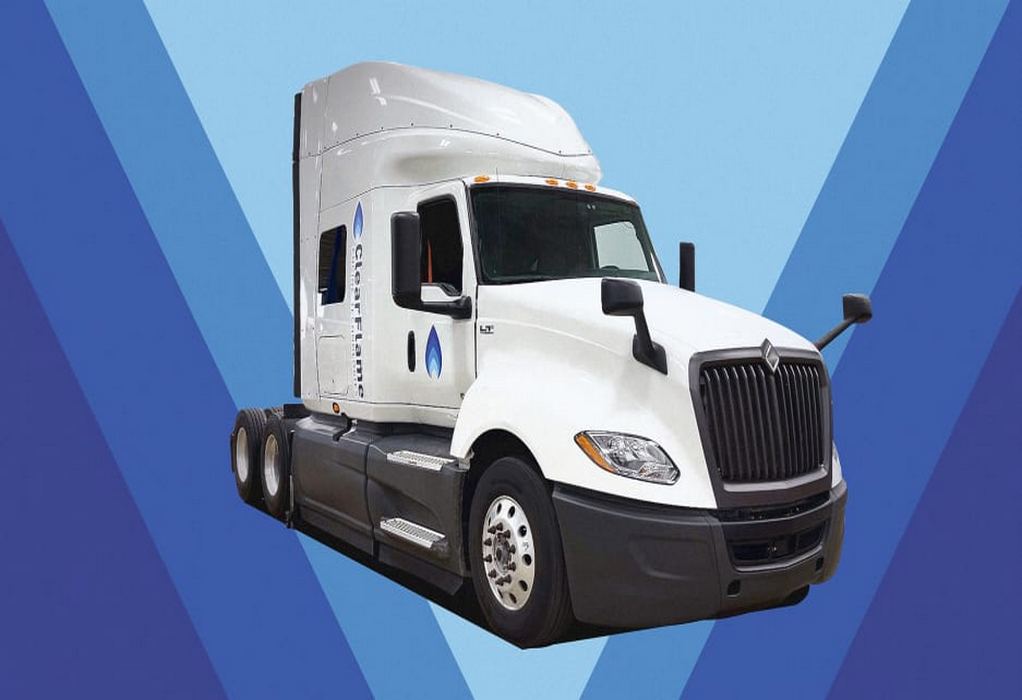The diesel big rig is starting to move into the carbon-free future: Electric semi trucks are already beginning to make deliveries around the country. But although they can work well for short trips—and Volvo’s newest electric semi will be able to travel up to 275 miles before charging—they still aren’t yet a viable alternative for the trucks that have to cross the country, which is how so much freight is moved. That’s why one startup is working on technology that can be put in use now: It tweaks diesel engines so they can use 100% renewable fuel, with no change in how the trucks run.
“Rather than trying to design an entirely new engine from the ground up, we said, okay, what is the minimum subset of parts and components we could swap inside this engine to make it fundamentally fuel agnostic, and to switch to something cleaner?” says BJ Johnson, CEO of the startup, called ClearFlame Engine Technologies, which recently raised $17 million from investors including Bill Gates-founded Breakthrough Energy Ventures.
In a new pilot test, the company converted the engine in a Class 8 truck—the largest class of trucks, weighing a minimum of 33,000 pounds—and tried driving it on 100% plant-based ethanol on a test track. There was “no loss of efficiency, no loss of power,” says cofounder Julie Blumreiter, who began developing the technology with Johnson when both were studying at Stanford University. “It sounds the same. It is a diesel engine in every sense of the word besides the fuel you use.” The key difference is the lack of pollution: Instead of black diesel smoke belching out of the tailpipe, the exhaust looks clear, and air pollution and climate emissions dramatically shrink.
Ethanol, which is typically made from corn, still has a carbon footprint, including the climate impact of fertilizer used to grow the crop. But current lifecycle data suggests that pure ethanol emits around 45-50% less greenhouse gases than diesel. And because the electric grid is still shifting to renewable electricity, the startup claims that a truck running on 100% ethanol is actually cleaner, at the moment, than an electric truck.
The technology insulates a diesel engine so it can run at a higher temperature, and alternative fuels like ethanol can ignite in the same way that diesel would. The converted engines can also use other fuels, such as fuels made from captured CO2. But right now, the startup is focused on ethanol, because it’s readily available and cheaper than diesel, so trucking companies and others that use diesel engines have an immediate incentive to switch. John Deere, another investor in the startup, could use the technology in farm or construction equipment. Diesel generators that are used for backup power could also convert their engines.
After more testing this year, the technology can be rolled out quickly. Service stations that already rebuild diesel engines can install the new parts with existing tools. And the underlying system can keep working. “We don’t have to wait for expansion of infrastructure for our technology to be adopted,” Johnson says. “We also don’t have to wait for entirely new power trains. We are not reinventing the wheel and rebuilding the engine from the ground up. We can start with the engines that are already out there today.” Fueling stations can operate the same way that they do now.
While electric vehicles already make sense for some applications, including passenger cars and trucks, school buses, and, say, postal delivery trucks, ClearFlame hopes to tackle vehicles that can’t transition as easily. There’s no single silver bullet solution, but the technology could help cut emissions significantly now. By one estimate, even as EVs become more popular, only 25% of new heavy-duty trucks will be zero-emissions more than a decade from now.
The speed of the transition matters, says Blumreiter, who compares emissions to interest on a bank account: Because CO2 builds up in the atmosphere, avoiding emissions now can have more impact than avoiding the same amount of emissions later. Globally, diesel engines are currently responsible for around 5 gigatons of CO2 emissions. “Even if we’re only cutting those carbon emissions in half—and to be clear, I think we absolutely will get to net zero on this in a decade or so—you’re looking at it at a gigaton-plus of carbon mitigation,” says Johnson.
ClearFlame will start testing the technology with customers later this year, while working with suppliers to make parts as quickly as possible. After EPA emissions testing, it could be on the market in 2023.
Source: Fast Company
Tags: Bill Gates, Diesel, Renewables, Volvo


Recent Posts
GCMD completes biofuel supply chain trials with Hapag-Lloyd
Airbus partners with Avolon on hydrogen aviation
Nuclear power transition more safe option for decarbonisation than coal
ABS presents industry’s first advisory on ammonia bunkering
AW Shipping orders multiple dual-fuel vessels from China
HIF Global partners with Airbus to advance development of SAF
ASL Aviation signs agreement with ZeroAvia for retrofit
AM Green plans to invest $1 bn to set up 2G biofuel plants